[ad_1]
(houseofbhakti.com) – The Creeper of Devotion Grows
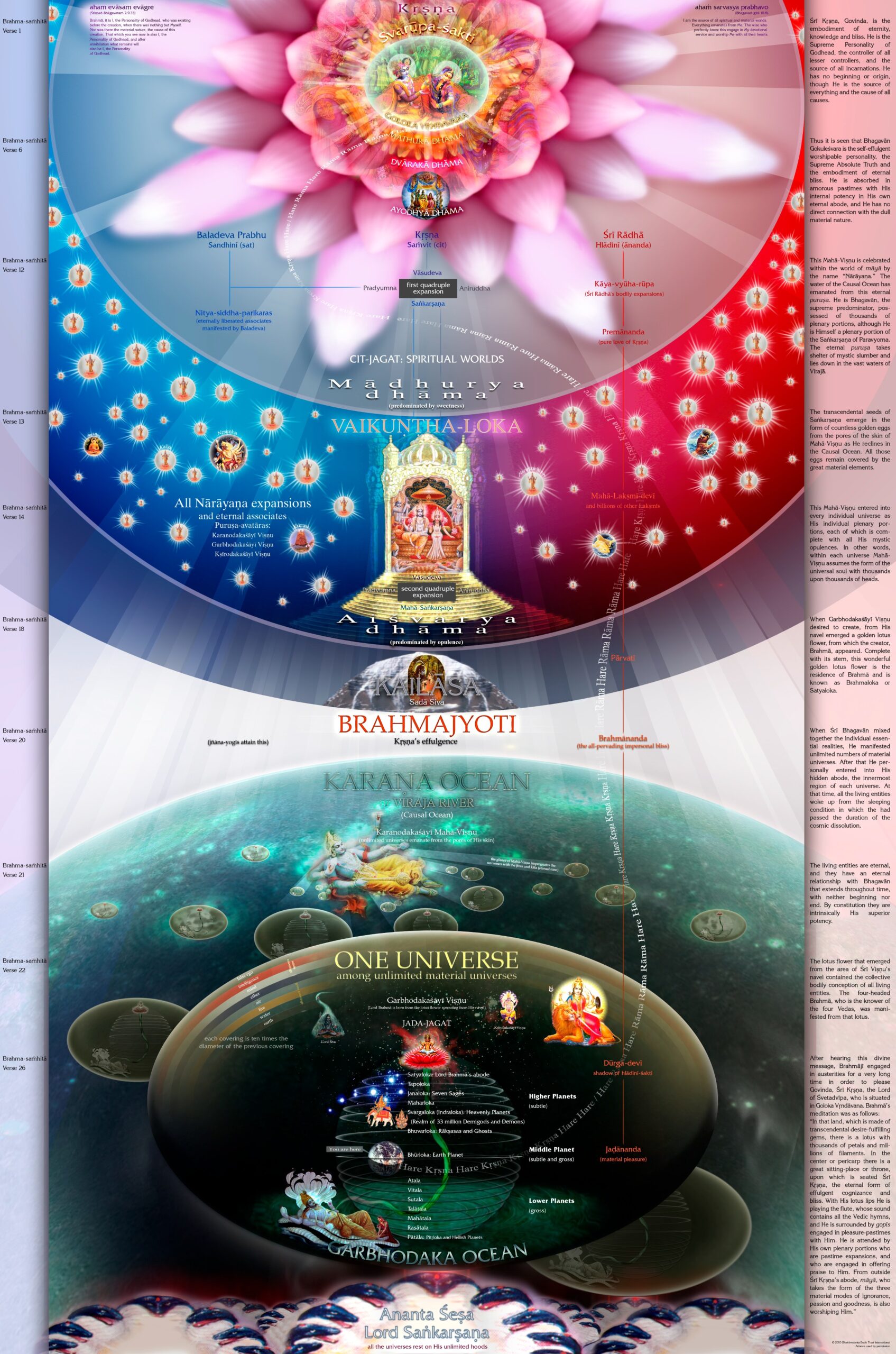
The following discourse on Śrī Caitanya-caritāmṛta, Madya-līlā Chapter 19, Śrī Rūpa-śikṣā was delivered by Śrīla Bhaktivedānta Nārāyaṇa Mahārāja in Toulouse, France, on July 7, 2002
The senior disciples of my śikṣā-guru Oṁ Viṣṇupāda Śrī Śrīmad Bhaktivedānta Svāmī Mahārāja, who have 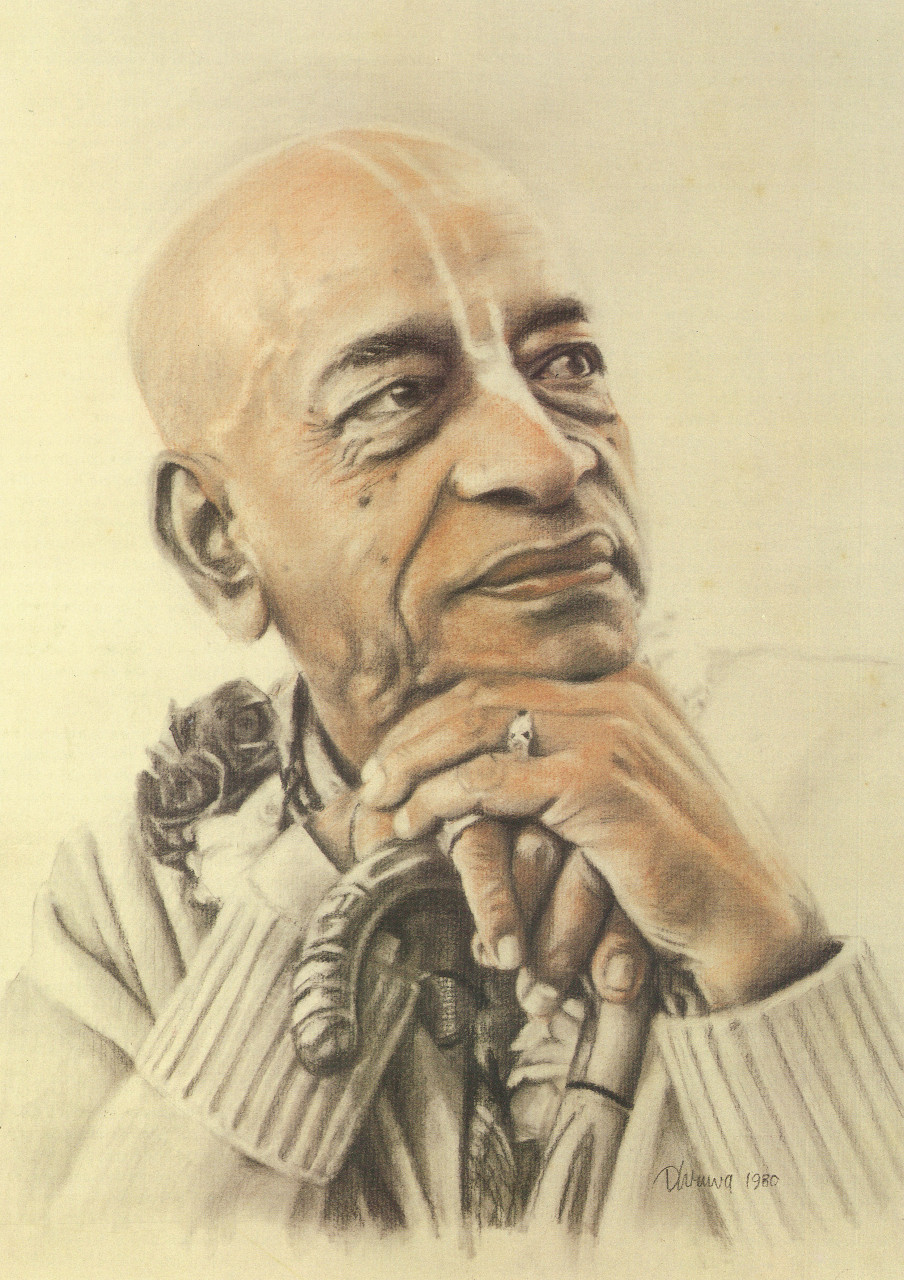 become somewhat weak after his divine departure, are now receiving new life. This was my main objective. I wanted to obey the words of my śikṣā-guru, to go wherever necessary to re-inspire his disciples and followers, and I think that we have been successful. Many thanks to the devotees who have left everything for the past seven days to come and hear hari-kathā. My blessings to all the devotees — that they will become very strong.
become somewhat weak after his divine departure, are now receiving new life. This was my main objective. I wanted to obey the words of my śikṣā-guru, to go wherever necessary to re-inspire his disciples and followers, and I think that we have been successful. Many thanks to the devotees who have left everything for the past seven days to come and hear hari-kathā. My blessings to all the devotees — that they will become very strong.
I advise you all to follow the path directed by Śrīla Bhaktivedānta Svāmī Mahārāja. For those of you who have not been following, I request that you once again follow his instructions — in the real sense. You should once again meditate on the dīkṣā-mantras he gave you, remembering everything that he told you regarding brahma-gāyatrī, guru-mantra, guru-gāyatrī, gaura-mantra, gaura-gāyatrī, kṛṣṇa-mantra, and kāma-gāyatrī.
You will not develop so much by chanting harināma by yourself, but if you chant in the association of superior Vaiṣṇavas and follow your Guru’s instructions, some fruit will come from your chanting. Caitanya-caritāmṛta states:
upajiyā bāḍe latā ‘brahmāṇḍa’ bhedi’ yāya
‘virajā’, ‘brahma-loka’ bhedi’ ‘para-vyoma’ pāya
(Śrī Caitanya-caritāmṛta, Madhya-līlā 19.153)
“As one waters the bhakti-latā-bīja, the seed sprouts, and the creeper gradually grows to the point where it penetrates the walls of this universe and goes beyond the Virajā River, which is lying between the spiritual world and the material world. It attains brahma-loka, the Brahman effulgence, and penetrating through that stratum it reaches the spiritual sky and the spiritual planet Goloka Vṛndāvana.”
The word upajiyā means “gradually developing.” In the beginning of the practice of bhakti there are many anarthas, and therefore there is no strong belief in the words of the Vaiṣṇavas, Kṛṣṇa, and śāstra. However, if we continue to hear hari-kathā in the association of Vaiṣṇavas, faith will develop. This faith is the aṅkura, sprout, of bhakti, which is the desire to serve Kṛṣṇa.
When one has this faith, he knows that by serving Kṛṣṇa his life will be successful, and he has the conviction that everything required for his life’s maintenance will be automatically taken care of. In this way he can use most of his energy in service to Kṛṣṇa, by chanting His names and remembering Him.
Gradually, two leaves appear from the sprout of the bhakti creeper: kleśa-ghnī (the disappearance of suffering) and śubhadā (the appearance of auspicious qualities) and after that two more appear, and then again two more.
In the very beginning, before taking dīkṣā, when one begins to chant in the association of devotees, he may have some faith in the devotees but he doesn’t yet realize the importance of taking shelter under a bona fide Guru. The Vaiṣṇava guru in whom he has strong faith tells him that he should take initiation; not only harināma, which can be given easily, but also dīkṣā initiation. He replies to that Vaiṣṇava, “I’m chanting as you have told me, but I have no taste. I have so many anarthas, and so much lust and desire for sense gratification.” The Guru tells him, “Take initiation; don’t delay.” He tells the Guru, “I want to take it, but I don’t want to shave off my dreadlocks.” He wants to be like a female. He likes the mood of ladies and ladies who cut their hair short want to be like males. Gurudeva finally concedes, “Then remain as you are. I will not initiate you.”
Another person, however, becomes ready to take shelter of the Guru; he will very easily give up his unwanted habits and paraphernalia. Those who hesitate do so because they fear that their desires for sense gratification won’t be fulfilled, whereas one who has strong faith will surrender at once, and thus his relationship with the spiritual master becomes very strong; he will obey his Gurudeva’s every instruction. Śrī Caitanya Mahāprabhu told Śrī Sanātana Gosvāmī, “Go to the Ganges, take a bath, and shave. Be like a gentleman.” Śrī Sanātana Gosvāmī immediately left for the Ganges, where he shaved and also gave up his valuable garments. He made his life very simple.
Spiritual life is very difficult to practice in Western countries. One cannot live like Indians there, because the atmosphere is unfavourable for that. It is not possible to go anywhere without the use of a car or similar transport, and in some places it is sometimes so cold that you will have to wear many thick and heavy garments. 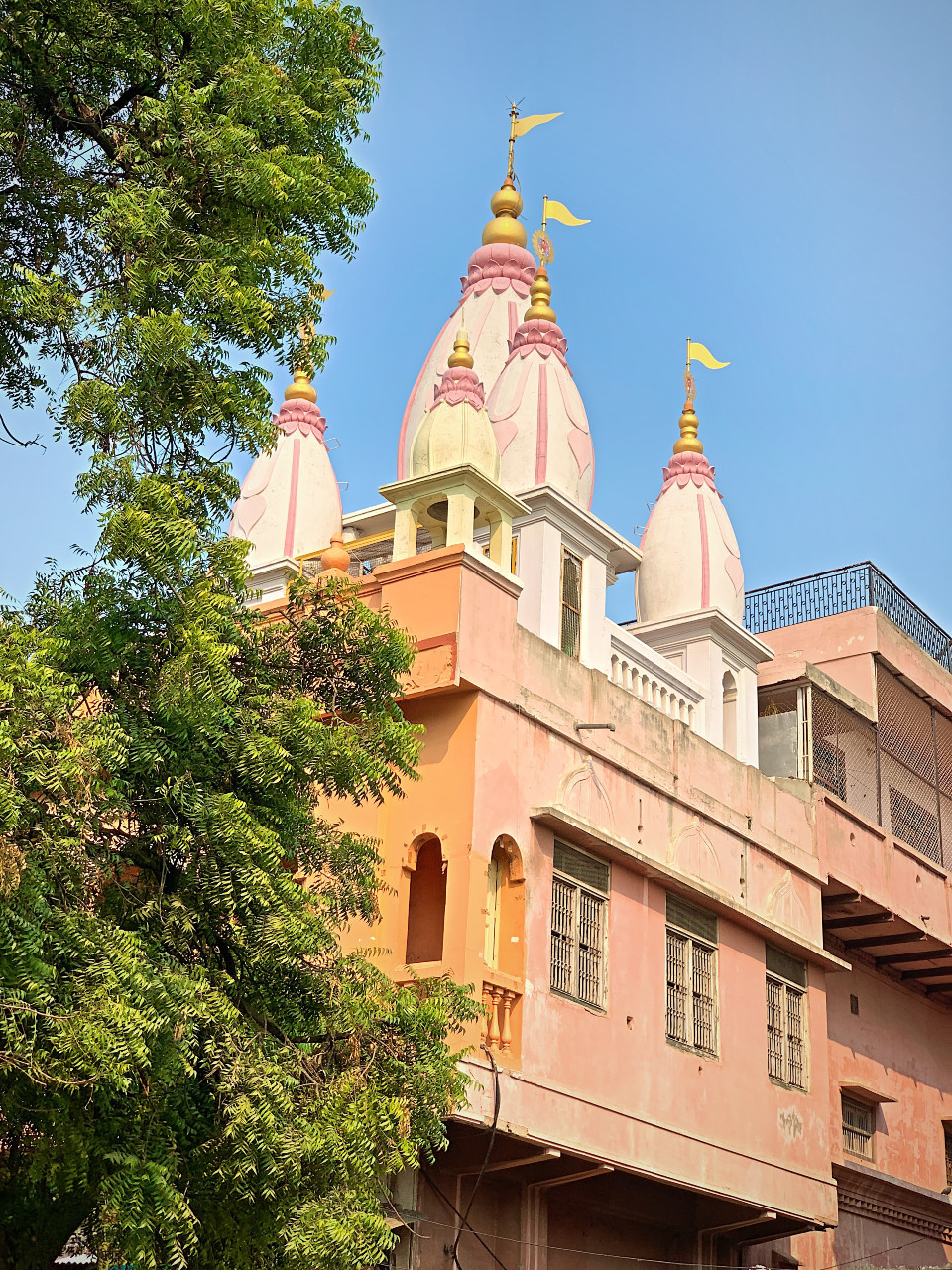 There are so many things you cannot avoid in the West, whereas India is favourable for spiritual life. In the West one requires money to walk from here to there, for the airport, and for this and that. But this is not the case in India, where there is not even the need for shoes and socks. It has therefore been said, ‘Bhārata-bhūmi sādhana-bhūmi’. In Bhārata, India, there is no need for more than the barest of necessities. Jagannātha Purī, for instance, is neither too hot nor too cold, and in Vṛndāvana you can beg mādhukarī (alms of prasādam) from almost any householder, because no one there eats meat, eggs, or fish, and they do not even smoke. It is very easy to maintain oneself in a spiritual way because so many residents of the dhāma are brahminical. Any sādhu can beg bhikṣā (alms), and most of the householders will gladly give him whatever he requests. Here in the West, however, you will have to buy everything yourself, and you will also have to cook for yourself; hardly anyone will give you anything. Therefore, India is very conducive to spiritual life.
There are so many things you cannot avoid in the West, whereas India is favourable for spiritual life. In the West one requires money to walk from here to there, for the airport, and for this and that. But this is not the case in India, where there is not even the need for shoes and socks. It has therefore been said, ‘Bhārata-bhūmi sādhana-bhūmi’. In Bhārata, India, there is no need for more than the barest of necessities. Jagannātha Purī, for instance, is neither too hot nor too cold, and in Vṛndāvana you can beg mādhukarī (alms of prasādam) from almost any householder, because no one there eats meat, eggs, or fish, and they do not even smoke. It is very easy to maintain oneself in a spiritual way because so many residents of the dhāma are brahminical. Any sādhu can beg bhikṣā (alms), and most of the householders will gladly give him whatever he requests. Here in the West, however, you will have to buy everything yourself, and you will also have to cook for yourself; hardly anyone will give you anything. Therefore, India is very conducive to spiritual life.
bhārata-bhūmite haila manuṣya janma yāra
janma sārthaka kari’ kara para-upakāra
(Śrī Caitanya-caritāmṛta, Ādi-līlā 9.41)
[“One who has taken his birth as a human being in the land of India (Bhārata-varṣa) should make his life successful and work for the benefit of all other people.”]
This utkaṇṭhā (eagerness) is essential: “I must live in India so that I can do bhajana.” It is stated in Śrīla Rūpa Gosvāmī’s Bhakti-rasāmṛta-sindhu:
kleśa-ghnī śubhadā mokṣa-
laghutākṛt sudurlabhā
sāndrānanda-viśeṣātmā
śrī-kṛṣṇākarṣiṇī ca sā
[“Pure devotional service brings immediate relief from all kinds of material distress. It is the beginning of all auspiciousness. It minimizes the value of liberation. It is rarely achieved, it automatically puts one in transcendental pleasure, and it is the only means to attract Kṛṣṇa.”]
When the disciple begins to follow the process of bhakti in the real sense, by chanting, hearing etc., the first two leaves of the bhakti creeper will appear: kleśa-ghnī and śubhadā. The symptom of the appearance of the first leaf, kleśa-ghnī, is that the disciple will see that the problems of his life are decreasing. Dukha-nivṛtti — dukha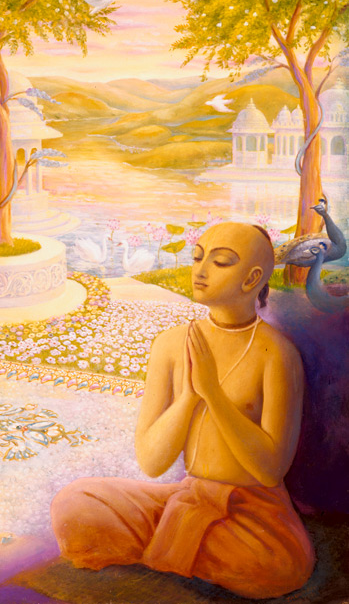 means unhappiness, and nivṛtti means decreasing. All kinds of suffering quickly disappear. Then, with the appearance of the second leaf, all kinds of favourable qualities begin to appear, and this is called śubhadā in Sanskrit. At this time many people begin to honour and pay respects to that sādhaka. They give him everything he requires to maintain his life: someone gives him fruits, another gives him clothes, another gives him shoes, etc. Kṛṣṇa is now beginning to make arrangements for his maintenance.
means unhappiness, and nivṛtti means decreasing. All kinds of suffering quickly disappear. Then, with the appearance of the second leaf, all kinds of favourable qualities begin to appear, and this is called śubhadā in Sanskrit. At this time many people begin to honour and pay respects to that sādhaka. They give him everything he requires to maintain his life: someone gives him fruits, another gives him clothes, another gives him shoes, etc. Kṛṣṇa is now beginning to make arrangements for his maintenance.
Gradually the second pair of leaves sprout, and they are called mokṣa–laghutākṛt and sudurlabhā. At the stage of mokṣa–laghutākṛt, the devotee no longer desires worldly sense gratification or even mukti; he sees liberation as insignificant. The word sudurlabhā means extremely rare, and it refers to rāgānugā-bhakti. That rare bhakti, sudurlabhā bhakti, now makes its appearance, and thus the devotee becomes kṛṣṇākarṣiṇī; he can attract Kṛṣṇa. Kṛṣṇākarṣiṇī is one of the leaves of the third pair, and the other leaf, sāndrānanda-viśeṣātmā: (condensed and unlimited happiness) now manifests. * [See Endnote 1] At that time the devotee becomes overjoyed because Kṛṣṇa may sometimes give him His darśana. By the mercy of Nityānanda Prabhu, when Śrī Kṛṣṇadasa Kavirāja Gosvāmī went to Vṛndāvana, he saw its beauty. He saw it as it was at the time when Kṛṣṇa was there. By the influence of bhakti, Kṛṣṇa and His abode will also manifest to you, and then your life will be successful.
Before this stage, when the devotee is at the stage of niṣṭhā, unwanted desires and anarthas are somewhat gone. Then, after niṣṭhā comes ruci, and then āśakti manifests. These are some of the stages of sādhana-bhakti, and in this way the devotee’s bhakti gradually develops.
If you see that after many years of trying to practice sādhana-bhakti that lust, desire for sense gratification, and anarthas are not disappearing, you can understand that there is something wrong with you or with your guru. If the guru cannot help you to give these up, you should give up that guru. The real guru is he who can help the devotee in his Kṛṣṇa consciousness. If the guru is not doing sādhana-bhajana, or chanting harināma, but is always managing, making money, and keeping a big bank account, he is bogus and he should be rejected. If your guru is bona fide but there is still something wrong, you should try to repair it. Give up whatever is unfavourable for bhakti at once, and in this way your bhakti creeper will develop.
upajiyā bāḍe latā ‘brahmāṇḍa’ bhedi’ yāya
‘virajā’, ‘brahma-loka’ bhedi’ ‘para-vyoma’ pāya
(Śrī Caitanya-caritāmṛta, Madhya-līlā 19.153)
“As one waters the bhakti-latā-bīja, the seed sprouts, and the creeper gradually grows to the point where it penetrates the walls of this universe and goes beyond the Virajā River which is lying between the spiritual world and the material world. It attains brahma-loka, the Brahman effulgence, and penetrating through that stratum it reaches the spiritual sky and the spiritual planet Goloka Vṛndāvana.”
Upajiyā bāḍe latā ‘brahmāṇḍa‘ bhedi’ yāya: All material desires reside in brahmāṇḍa (this universe) like, “I will be king,” “I will be Prime Minister,” I will be President,” “I want to have all kinds of happiness and all kinds of sense gratification.” Hiraṇyakaśipu received a great boon from Brahmā, but that boon could not liberate him from the brahmāṇḍa. It was within the brahmāṇḍa.
Your creeper of bhakti will dry up if you are thinking about how you will maintain yourself in this world, or you desire sense gratification, or you want to go to heaven. This is also within the brahmāṇḍa. Your bhakti creeper is still within the universe. If you would like to be like Sanaka, Sanandana, Sanātana, and Sanat-kumāra (in their previous life as Brahmavādīs), or even if you have become like Brahmā, with the ability to create and so forth, your creeper is still inside the brahmāṇḍa.
Try to realize the nature of this brahmāṇḍa. All material desires keep you bound here. If your bhakti is pure, you will not have any worldly desires; so try to act in accordance with the principles ordained in the following śloka:
tan-nāma-rūpa-caritādi-sukīrtanānu-
smṛtyoḥ krameṇa rasanā-manasī niyojya
tiṣṭhan vraje tad-anurāgi-janānugāmī
kālaṁ nayed akhilam ity upadeśa-sāram
(Śrī Upadeśāmṛta Verse 8)
[“The essence of all advice is that one should utilize one’s full time — twenty-four hours a day — in nicely chanting and remembering the Lord’s divine name, transcendental form, qualities and eternal pastimes, thereby gradually engaging one’s tongue and mind. In this way one should reside in Vraja [Goloka Vṛndāvana dhāma] and serve Kṛṣṇa under the guidance of devotees. One should follow in the footsteps of the Lord’s beloved devotees, who are deeply attached to His devotional service.”]
If you cannot be in Vṛndāvana physically, then try to meditate on Vṛndāvana. If you always chant and remember under the guidance of a rasika-tattvajña Vaiṣṇava, your bhakti will increase.
upajiyā bāḍe latā ‘brahmāṇḍa’ bhedi’ yāya
‘virajā’, ‘brahma-loka’ bhedi’ ‘para-vyoma’ pāya
(Śrī Caitanya-caritāmṛta, Madhya-līlā 19.153)
“As one waters the bhakti-latā-bīja, the seed sprouts, and the creeper gradually grows to the point where it penetrates the walls of this universe and goes beyond the Virajā River which is lying between the spiritual world and the material world. It attains brahma-loka, the Brahman effulgence, and penetrating through that stratum it reaches the spiritual sky and the spiritual planet Goloka Vṛndāvana.”
The Virajā River is not influenced by jñāna, karma, yoga, tapasya, etc. In a sense, neither rajas nor tamas (the material modes of passion and ignorance) is present in the Virajā River; only śuddha–sattva, (pure goodness), is there. In another sense, sattva, rajas and tamas are there, but they are mūrcchita (sleeping or lying dormant). They can wake up at any time, however. This means that the jīva may again fall victim to the material energy even if he is situated in the Virajā River, because there is no positive spiritual activity there. The bhakti creeper crosses beyond the Virajā River and bypasses Brahmaloka. * [See Endnote 2] What is Brahmaloka? In this śloka (upajiyā bāḍe latā…) Brahmaloka does not refer to the residence of Lord Brahmā. It refers to the impersonal brahmajyoti. By brahma-jñāna, one may enter and merge in brahma, and at that time he thinks, “I am brahma.” But bhakti-devī can easily cross over this Brahmaloka, and in fact she does not even see it.
The bhakti creeper then goes to paravyoma [the spiritual sky], which is beyond even Śivaloka. Paravyoma, 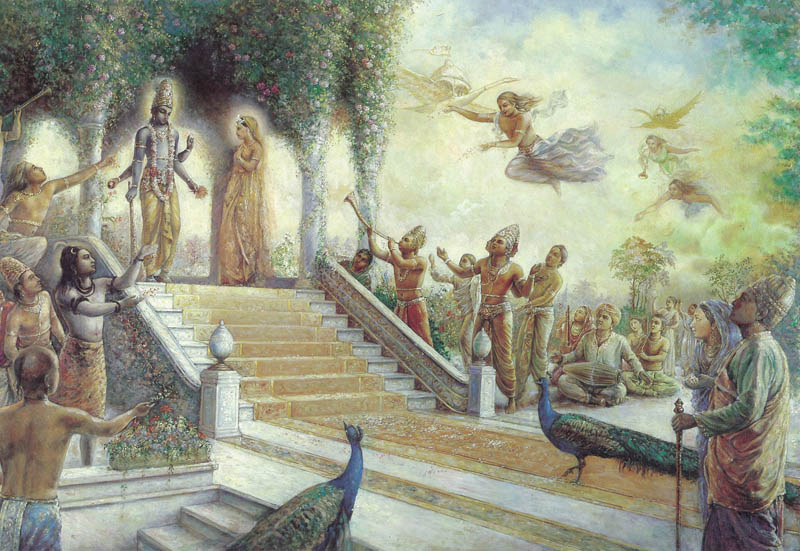 where there is no mixing in brahma, is divided into two sections. The lower of the two is like Vaikuṇṭha, but is not actually Vaikuṇṭha, and the jīva can also go there. It is the Vaikuṇṭha planet within the material world, and it is called Ramāpriya Vaikuṇṭha. In that realm there is sevā-sukha-aiśvarya-uttarā. There, the devotee wants to serve Lord Nārāyaṇa, but he also wants the happiness accrued from the attainment of the four spiritual opulences. That desire for happiness is not like ours, for the devotees there do not have material bodies; still, that desire is not pure. In the higher section there is prema-sevā–uttarā; the devotee only wants to serve Nārāyaṇa with love.
where there is no mixing in brahma, is divided into two sections. The lower of the two is like Vaikuṇṭha, but is not actually Vaikuṇṭha, and the jīva can also go there. It is the Vaikuṇṭha planet within the material world, and it is called Ramāpriya Vaikuṇṭha. In that realm there is sevā-sukha-aiśvarya-uttarā. There, the devotee wants to serve Lord Nārāyaṇa, but he also wants the happiness accrued from the attainment of the four spiritual opulences. That desire for happiness is not like ours, for the devotees there do not have material bodies; still, that desire is not pure. In the higher section there is prema-sevā–uttarā; the devotee only wants to serve Nārāyaṇa with love.
There is great aiśvarya (opulence) in the Vaikuṇṭha planets: one can have the same bodily features as Nārāyaṇa (sārūpya), he can live on the same planet with Him (sālokya), he can have equal opulence (sārṣṭi), and he can have association with the Lord (sāmīpya). But a Vaiṣṇava never wants these four types of liberation; he solely wants to serve.
Nārāyaṇaloka, Nṛsiṁhaloka, Rāmaloka (Ayodhyā), and many other such lokas are within the paravyoma, and the bhakti creeper passes beyond all of them. It crosses beyond nārāyaṇa-bhakti, nṛsiṁha-bhakti, and rāmacandra-bhakti. The devotee will say, “I don’t want that,” and that creeper then goes to Goloka.
Goloka is also divided into three sections: Dvārakā, Mathurā, and Gokula. The bhakti creeper very quickly passes through Dvārakā and Mathurā and comes to Gokula. From Gokula, it goes to Vṛndāvana, and then, within Vṛndāvana, it goes to Nandāgaoṅ and Varṣāṇā. From there it goes to Govardhana and from there to Rādhā-kuṇḍa. Rādhā and Kṛṣṇa are playing there in Rādhā-kuṇḍa, and the creeper is serving Their lotus feet there. That is where it stops. It produces fruits and flowers that give pleasure to Śrī Śrī Rādhā-Kṛṣṇa Yugala. Many mañjarīs also come to that Rādhā-kuṇḍa, which is full of beautiful flowers and sweet fruits.
Where is the gardener (caretaker of the seed) at this time? He is still in this world, but what stage is he in? If his creeper is within the brahmāṇḍa, he is a kaniṣṭha–adhikārī, whereas at the stage of bhāva-bhakti it has passed through the brahmāṇḍa, the Virajā River, Śivaloka, etc., and enters Nārāyaṇaloka, or Vaikuṇṭhaloka. Then, when the seed of love of God (bhāva-bhakti) matures and transforms into the ripened fruit of vraja-prema, it is then that one’s bhakti is able to pass all other places — including Goloka.
The creeper takes shelter of Mother Yaśodā in Gokula, and after that it takes shelter of the gopīs, then 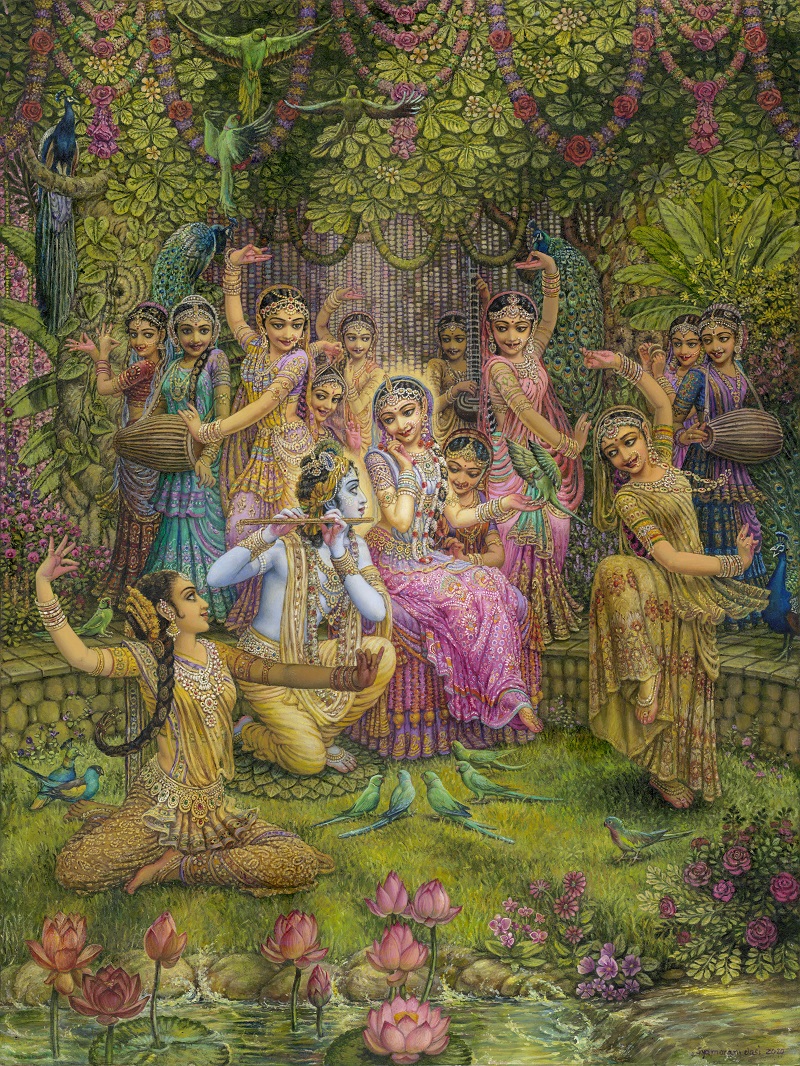 Vṛndāvana, and then the shelter of Govardhana. Within Govardhana, the creeper takes shelter of Rūpa-mañjarī and then under the guidance of Rūpa-mañjarī and Anaṅga-mañjarī, it goes to Rādhā-kuṇḍa. There, at Rādhā-kuṇḍa, the devotee serves Rādhā-Kṛṣṇa Conjugal with a tendency towards Śrīmati Rādhikā. The creeper can go only up to there — there is no place after this.
Vṛndāvana, and then the shelter of Govardhana. Within Govardhana, the creeper takes shelter of Rūpa-mañjarī and then under the guidance of Rūpa-mañjarī and Anaṅga-mañjarī, it goes to Rādhā-kuṇḍa. There, at Rādhā-kuṇḍa, the devotee serves Rādhā-Kṛṣṇa Conjugal with a tendency towards Śrīmati Rādhikā. The creeper can go only up to there — there is no place after this.
If there is a tree, a creeper will climb all over it, covering it entirely. In the same way, the bhakti creeper is now covering all rasas, especially mādhurya-rasa, and the devotee can serve Rādhā-Kṛṣṇa Conjugal in every way. This is the inner meaning of the words:
tabe yāya tad-upari ‘goloka-vṛndāvana’
‘kṛṣṇa-caraṇa’-kalpa-vṛkṣe kare ārohaṇa
(Śrī Caitanya-caritāmṛta, Madhya-līlā 19.154)
[“Being situated in one’s heart and being watered by śravaṇa-kīrtana, the bhakti creeper grows more and more. In this way it attains the shelter of the desire tree of the lotus feet of Kṛṣṇa, who is eternally situated in the planet known as Goloka Vṛndāvana, in the topmost region of the spiritual sky.”]
Devotee: Gurudeva, you seemed to say that at bhāva-bhakti one can go to Nārāyaṇa-loka, and at prema one can go to Vṛndāvana. I thought bhāva is just the less condensed state of prema. One has the same mood of devotion, devotion to the same iṣṭadeva, but it is simply not as developed. You seemed to say that the bhāva-bhakta changes his iṣṭadeva when he reaches prema.
Śrīla Bhaktivedānta Nārāyaṇa Mahārāja: After bhāvavasta (the stage of bhāva-bhakti), prema will come. If the devotee is on the path of vaidhī-bhakti, then he goes to Nārāyaṇaloka. If he is on the path of rāgānugā-bhakti, vraja-rāgānugā, then he will go directly to Vraja. There are two destinations — one coming from the execution of vaidhī-bhakti and another coming from rāgānugā-bhakti.
Devotee: So it’s not that the bhakti creepers of all bhāvavasta devotees go to Nārāyaṇaloka. Only those in vaidhī-bhakti.
Śrīla Bhaktivedānta Nārāyaṇa Mahārāja: How can I tell all these things in a moment — at one time?
* [Endnote 1: (Taken from Śrīla Bhaktivedānta Nārāyaṇa Mahārāja ‘s lecture on June 8, 2001 in Holland.)
What is it that is sudurlabhā? It has been told in Śrī Upadeśāmṛta that even devotees like Nārada cannot attain that kind of bhāva-bhakti. What is sudurlabhā? To serve Rādhā-Kṛṣṇa Conjugal like the Vrajavāsīs is very rare. Even for premī-bhaktas it is very difficult to attain this. ‘Yat preṣṭhair apy alam asulabhaṁ‘. [“Undoubtedly Rādhā-kuṇḍa is very rarely attained even by the great devotees; therefore it is even more difficult for ordinary devotees to attain.” (Upadeśāmṛta text 11)] Even for those who have love and affection, this kind of bhāva-bhakti, this rāgānugā-bhakti and rāgātmikā bhakti, are very, very, very rare. This is called sudurlabhā.
In comparison, it is very easy to go to Vaikuṇṭha. You know that Ajāmila quickly went there. How did he attain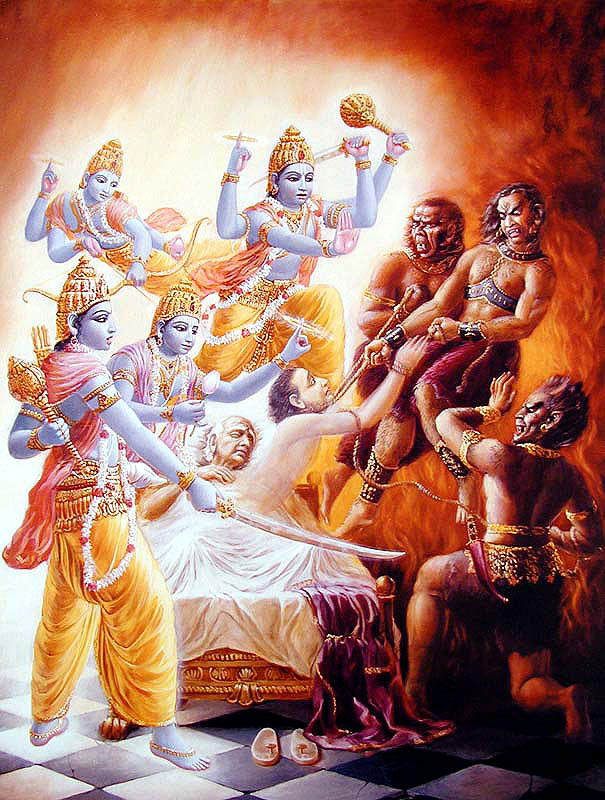 this? He was only calling out the name of Nārāyaṇa with reference to his son. By this chanting, nāmābhāsa came, and then four associates of Nārāyaṇa, holding śaṅkha, cakra, gadā, and padma in their four hands, came to him. They explained to him the glorification of these Names. We see here that even nāmābhāsa is so high, and what to say of śuddha-nāma!
this? He was only calling out the name of Nārāyaṇa with reference to his son. By this chanting, nāmābhāsa came, and then four associates of Nārāyaṇa, holding śaṅkha, cakra, gadā, and padma in their four hands, came to him. They explained to him the glorification of these Names. We see here that even nāmābhāsa is so high, and what to say of śuddha-nāma!
After their discussion, Ajāmila returned to external consciousness and left his wife, children and everything else. He went to Haridvāra where he took a bath in the Ganges, and there he adopted the mantra and process given to him by the four Viṣṇudūtas. By chanting and chanting, prema for Nārāyaṇa came, and by this prema Ajāmila went to Vaikuṇṭha. It was not by nāmābhāsa that he went there. No one can go to Vaikuṇṭha by nāmābhāsa. One can only attain that realm by pure śuddha-nāma.
Still, in Vaikuṇṭha there is some opulence. Anyone can easily go there, but to go to Vraja is very high. Rūpa Gosvāmī has explained all these things.
The fifth leaf on the creeper of bhakti is sāndrānanda–viśeṣātmā… What is viśeṣātmā?
You should know this. You know sandhinī, samvit, and hlādinī. [“The transcendental potency of the Supreme Personality of Godhead by which He maintains His existence is called sandhinī. The transcendental potency by which He knows Himself and causes others to know Him is called samvit. The transcendental potency by which He possesses transcendental bliss and causes His devotees to have bliss is called hlādinī. The total exhibition of these potencies is called viśuddha-sattva…” Śrī Caitanya-caritāmṛta, Ādi-līlā 4.62 Purport)] On the platform of sandhinī, anything transformed by sandhinī is called śuddha-sattva. When the essence of hlādinī and samvit mix together and appear on the platform of sandhinī, or śuddha-sattva, this is called viśeṣātmā.
What is the meaning? Hlādinī is directly Śrīmati Rādhikā Herself, who is svarūpa-śakti. The highest mood of that svarūpa-śakti is the mood of hlādinī. This hlādinī mood in its highest stage, mādana, is not even in Kṛṣṇa, and it is this mādana that Kṛṣṇa wants to taste and realize. This mood is found only in the essence of hlādinī, who is Rādhikā Herself. The moods in Rādhikā, the moods of how to serve and please Kṛṣṇa, is called mahābhāva.
What is bhāva? Bhāva is coming from samvit. Samvit is the potency of knowledge, but when that knowledge is 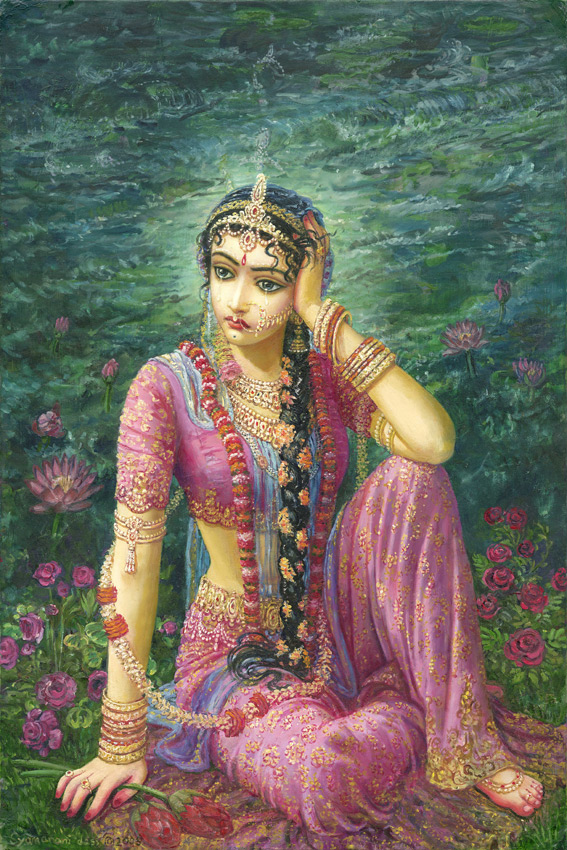 condensed, it is transformed into bhāva, and bhāva is transformed into sneha, māna, praṇaya, rāga, anurāga, bhāva, and mahābhāva. This mahābhāva is the moods in Rādhikā. These moods are thus the essence of samvit and hlādinī, the moods of service to Kṛṣṇa in the highest way, and they come on the platform of śuddha-sattva.
condensed, it is transformed into bhāva, and bhāva is transformed into sneha, māna, praṇaya, rāga, anurāga, bhāva, and mahābhāva. This mahābhāva is the moods in Rādhikā. These moods are thus the essence of samvit and hlādinī, the moods of service to Kṛṣṇa in the highest way, and they come on the platform of śuddha-sattva.
What is sattva? It is any transformation of sandhinī. Within sandhinī, any jīva who is liberated is called śuddha-sattva, and Kṛṣṇa and His svāṁśa or manifestations are called viśuddha-sattva. Jīvas are not viśuddha-sattva, but they may be śuddha-sattva. Aśuddha-sattva are those who are not liberated, śuddha-sattva are liberated, and viśuddha-sattva refers to Kṛṣṇa and His all incarnations including Viṣṇu. When viśuddha-sattva combines with the essence of hlādinī and samvit and comes in a jīva, that essential mood to serve Kṛṣṇa will be sāndrānanda–viśeṣātmā; otherwise not. This is a very elevated topic.]
* [Endnote 2: “Outside of the Vaikuṇṭha planets is the impersonal manifestation of Śrī Kṛṣṇa, which is known as Brahmaloka. On the other side of Brahmaloka is the spiritual kāraṇa–samudra, or Causal Ocean. The material energy exists on the other side of the Causal Ocean, without touching it.” (Śrī Caitanya-caritāmṛta, Ādi-līlā Chapter 5 Introduction.)]
Source: Purebhakti.com
Maps & Diagrams: Bvtridandi.com
Image/Art made possible by Pixabay.com, Krishnapath.org and/or Bhaktiart.net
Unless indicated differently, all verse translations and quotes are from the books by Śrīla Bhaktivedānta Svāmī Mahārāja Prabhupāda (Vedabase.com)

[ad_2]







